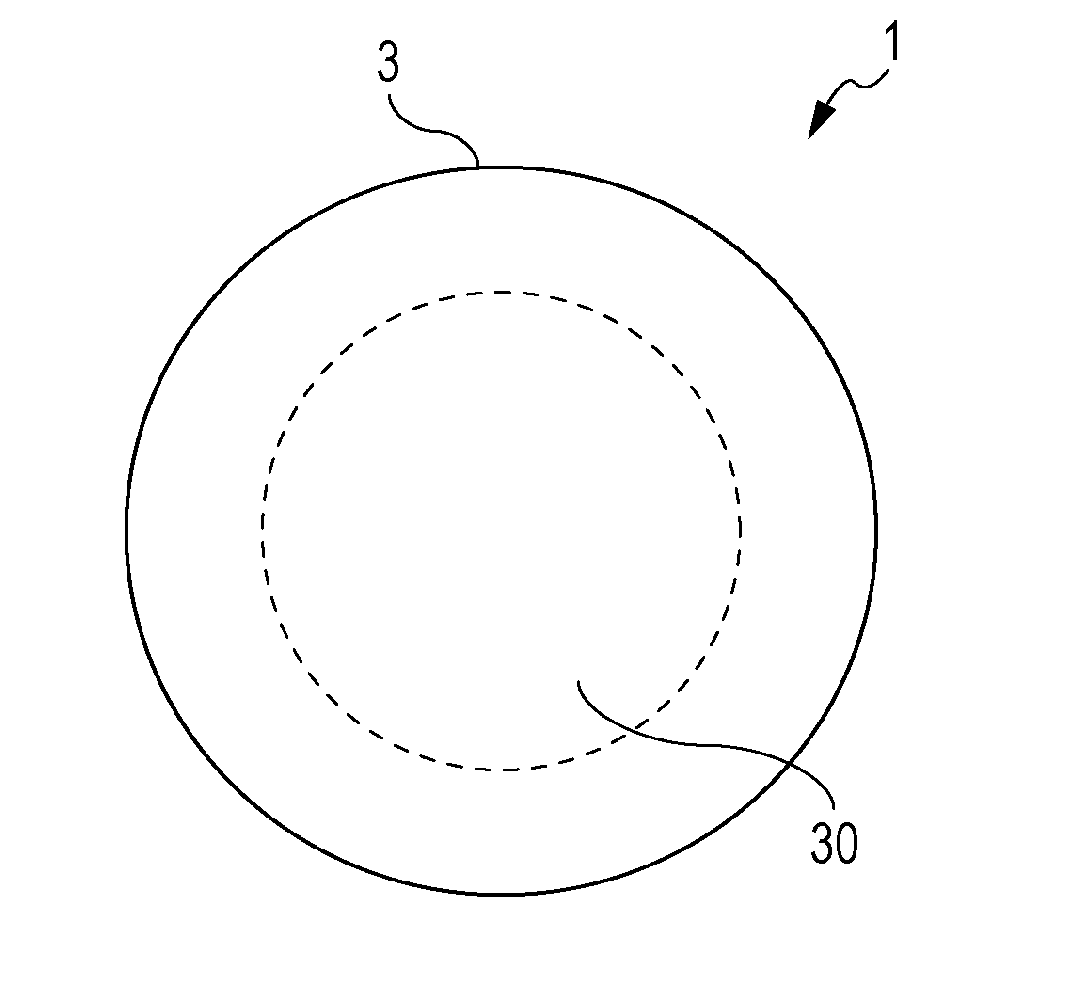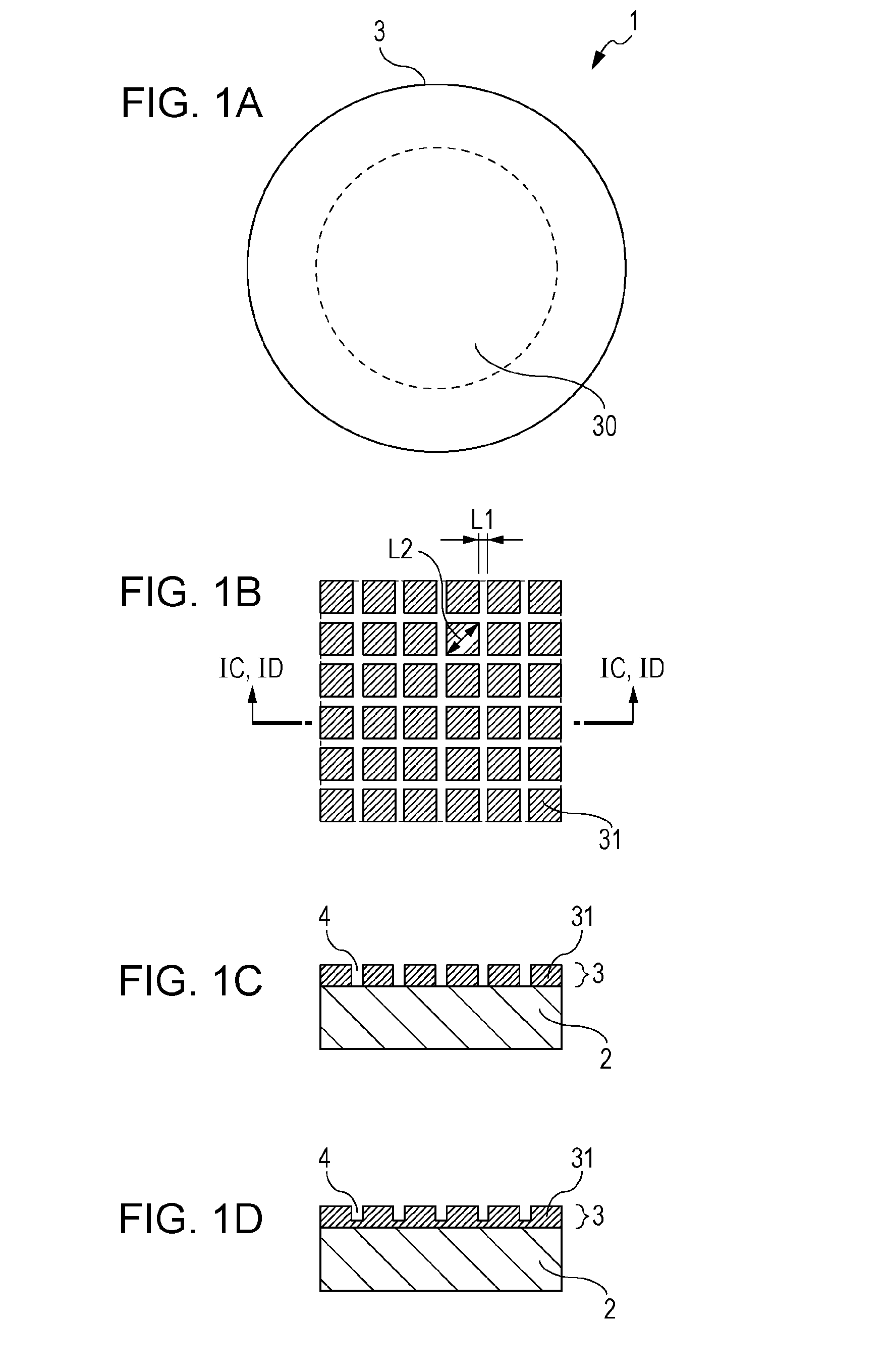Target structure and radiation generating apparatus
a radiation generation apparatus and target technology, applied in the direction of material analysis using wave/particle radiation, instruments, x-ray tube targets and convertors, etc., can solve the problems of inapplicability of technology to transmissive targets, significant limit in the combination of materials to be used, and separation of target layers or intermediate thin films
- Summary
- Abstract
- Description
- Claims
- Application Information
AI Technical Summary
Benefits of technology
Problems solved by technology
Method used
Image
Examples
first embodiment
[0020]FIGS. 1A to 1D are schematic drawings illustrating a transmissive target structure of a first embodiment. FIG. 1A is a top view, FIG. 1B is an enlarged drawing of an area 30 in FIG. 1A, and FIGS. 1C and 1D are cross-sectional views taken along the line IC, ID-IC, ID in FIG. 1B.
[0021]A target structure 1 includes a substrate 2 and a target layer 3 formed on a surface of the substrate 2. When an electron beam enters the target layer 3, radiation is generated, and part of the generated radiation transmits through the substrate 2 and is emitted to the opposite side of the target layer 3.
[0022]Materials which constitute the substrate 2 can be those having strength enough for supporting the target layer 3, absorbing little radiation generated in the target layer 3, and having a high thermal conductivity so as to be capable of releasing heat generated in the target layer 3 quickly. For example, diamond, silicon carbide, silicon nitride, aluminum nitride may be used. The thickness of ...
second embodiment
[0033]FIGS. 3A and 3B are cross-sectional views of a radiation-transmissive type target structure of a second embodiment. In the second embodiment, an intermediate layer 5 is provided between the substrate 2 and the target layer 3, and other configuration may be the same as those in the first embodiment.
[0034]In FIGS. 3A and 3B, the intermediate layer 5 has a function to further improve adhesiveness between the substrate 2 and the target layer 3. The material which constitutes the intermediate layer 5 can be a material having good adhesiveness with respect to the material which constitutes the substrate 2 and the target layer 3. Examples of such materials include titanium, chrome, vanadium, tantalum, or alloy or compound containing such metals. The intermediate layer 5 may have a function to allow heat generated in the target layer 3 to be conducted to the substrate 2.
[0035]The thickness of the intermediate layer 5 can be a thickness which ensures the adhesiveness between the substr...
third embodiment
[0040]In a third embodiment, a protective layer 6 covering the target layer 3 is provided without covering the depressed portions 4 of the target layer 3, and other configurations are the same as those in the first embodiment.
[0041]In FIG. 4, the protective layer 6 is configured to restrain separation or lifting of the target layer 3, and the material of the protective layer 6 can be those having good adhesiveness with respect to the materials of the substrate 2 and the target layer 3, and having a coefficient of thermal expansion close thereto. In addition, a material having relatively small atomic numbers which have a large electron penetration depth can be sued for reducing the absorption of the electron beam in the protective layer 6. Examples of options of such materials include titanium, nickel, zirconium, chrome, niobium, silicon, or alloy or compound containing such metals. The protective layer 6 can also be formed continuously so as to cover the target layer 3 and the depre...
PUM
| Property | Measurement | Unit |
|---|---|---|
| thickness | aaaaa | aaaaa |
| width | aaaaa | aaaaa |
| width | aaaaa | aaaaa |
Abstract
Description
Claims
Application Information
 Login to View More
Login to View More - R&D
- Intellectual Property
- Life Sciences
- Materials
- Tech Scout
- Unparalleled Data Quality
- Higher Quality Content
- 60% Fewer Hallucinations
Browse by: Latest US Patents, China's latest patents, Technical Efficacy Thesaurus, Application Domain, Technology Topic, Popular Technical Reports.
© 2025 PatSnap. All rights reserved.Legal|Privacy policy|Modern Slavery Act Transparency Statement|Sitemap|About US| Contact US: help@patsnap.com



